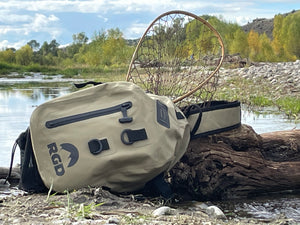For fly fishing, the beauty lies in the minimalist approach. Unlike gear-heavy conventional fishing, fly fishing prioritizes finesse and presentation over brute force. Here are the five most essential pieces of gear to get you started on your fly fishing adventure:
-
Fly Rod & Reel: The heart and soul of your setup, the fly rod propels your fly line and casts your flies with precision. Choose a rod weight appropriate for the species you're targeting and the size of flies you'll be using. An 8-foot, 5-weight rod is a versatile option for beginners. While not as crucial as the rod, a fly reel plays a vital role. It stores your fly line, helps manage slack during retrieves, and allows you to fight fish effectively. A simple single-action reel with smooth dragging capabilities is sufficient for most beginners.
-
Fly Line: The fly line acts as the bridge between your rod and your fly. It transfers casting energy and allows you to present your flies delicately. Floating lines are ideal for dry flies and emergers, while sinking lines are used for nymphs and streamers that need to get deeper in the water column. Don't forget about a leader & tippet. The leader is a tapered section of clear monofilament that connects your fly line to your tippet. The tippet, made of even finer material, is the thinnest part of your setup and directly attaches to your fly. Leaders and tippet material come in various weights and lengths, allowing you to tailor your presentation to specific situations.
-
Flies: While there are countless fly patterns, a basic selection with dry flies, nymphs, and streamers will cover a range of fishing scenarios. As you gain experience, you can expand your fly box to target specific fish species and imitate their natural food sources. Most fly shops can point you in the right direction for a nice starter selection of a dozen flies or so to get you casting.
-
Gear Bag: A waist bag/fanny pack, sling or backpack will help you stay organized while wading. Your gear is usually with you most of the time, there's no boat or tackle box. So select a bag that works for you. Most bags for fly fishing are made of waterproof material and have specific places for nets, flies and other gear.
-
Polarized Sunglasses: A quality pair of polarized glasses will cut through glare on the water's surface, allowing you to spot fish and navigate hazards more easily. They also protect your eyes from harmful UV rays.
With this essential gear and a thirst for learning, you'll be well on your way to experiencing the joys (and challenges) of fly fishing. Remember, practice casting in open areas before heading to the water, and prioritize ethical fishing practices like catch-and-release to preserve the sport for generations to come.

